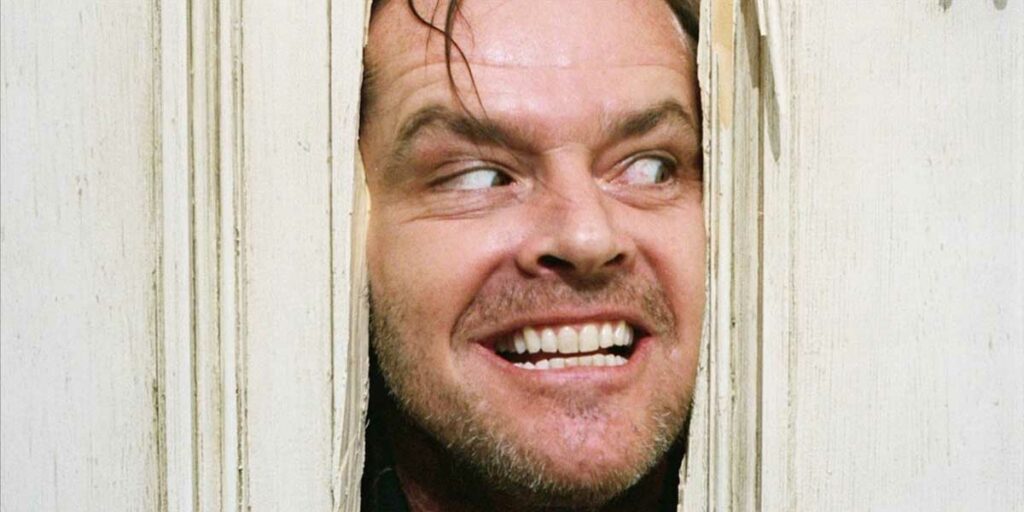The Shining achieves its status as a horror classic through its adept use of cinematic techniques, while underscoring the lasting impression it leaves on its audience.
This month, I had the pleasure of watching The Shining for the first time on the big screen at my local cinema. Despite the challenges posed by the pandemic, the family-owned theater undertook an ambitious renovation to recreate the iconic horror film’s distinct sets, including the gold bar, the red bathroom, and even the intricate hotel floor pattern. While the movie initially garnered mixed reviews, it has since solidified its status as a horror classic, and the reasons are evident. Kubrick’s meticulous craftsmanship maintains tension from the opening credits to the final scene, making The Shining a masterclass in the horror genre. It adeptly employs its score, setting, and cinematography to craft an unsettling atmosphere, ensuring viewers remain on the edge of their seats throughout the film.
Based on Stephen King’s 1977 novel, the film follows Jack Torrence (Jack Nicholson) as he acquires a caretaking job at the remote Overlook hotel during the winter season. As the hotel becomes snowbound, Jack grapples with his own demons while his psychic son, Danny (Danny Lloyd), begins to experience mysterious and disturbing premonitions from events that have taken place in the past. The hotel’s malevolent forces slowly begin to take over Jack’s spirit, and drive him to murderous insanity as he begins to attack his wife and young son. The film is rich with psychological horror, and provides the backdrop for the exploration of its various cinematic elements.
As the opening credits of the film begin to roll, it’s impossible to ignore the ominous score set against the backdrop of the serene Colorado mountains. Expertly crafted by Wendy Elkhind and Rachel Elkind, the music immediately signals to the audience that something is amiss, creating a stark contrast with the peaceful landscape and establishing a persistent sense of unease that lingers throughout the film’s duration. This serves as the first example of Kubrick’s skill in using the film’s score to establish its tension and tone.
Throughout the remainder of the movie, the score consistently contributes to the eerie ambiance, adding layers of depth to scenes that may not initially appear unsettling. With the music’s enhancement, even seemingly benign moments take on a spine-chilling quality. Additionally, Kubrick employs various techniques to maintain tension in different scenes, and during these instances, he skillfully knows when to dial back the score, leaving the audience with an eerie silence that amplifies the atmosphere.

The film is set within the Iconic Overlook Hotel, and its setting profoundly shapes the story’s horror elements. While many are familiar with the enigmatic room 237 and the eerie twin ghosts who beckon, the film also harnesses the mundane aspects of the hotel as sources of horror. The constant uncertainty about what might lurk around each corner keeps the audience perpetually on edge, and the film skillfully exploits this tension.
As young Danny rides his toy bike through the hotel lobby, there’s a perpetual sense of apprehension regarding what he might encounter each time he turns a corner. Early in the film, characters explore the exterior hedge maze that the hotel is renowned for, only for the maze itself to become the pivotal setting during the film’s climax. Even the opulent gold room bar, with its elegance and beauty, exudes an eerie atmosphere, with its vast emptiness when the characters visit and gradually encounter the other resident ghosts. And the red bathroom‘s appearance, reminiscent of the blood flooding from the elevator early in the film, adds to the disquieting atmosphere during the characters’ already unsettling conversation.
From a filmmaking perspective, Kubrick masterfully manipulates his camera to immerse the viewer in an unsettling experience. He frequently employs low-angle shots to make it appear as though the characters are being followed or pursued by an unknown entity. This technique is particularly evident during the climax, where the camera tracks every swing of Jack’s axe as he tries to break down the doors. In a later scene, Kubrick combines these techniques as Jack chases Danny through the maze, visually confirming the pervasive feeling of being pursued that has been present throughout the film.
In stark contrast, he seamlessly alternates between these techniques and a still camera, evoking a sense of helplessness in the audience. Viewers are reduced to mere observers, unable to intervene as the horrifying events unfold before their eyes.
Despite its initial reception, The Shining has rightfully earned its status as a horror masterpiece. It’s not hard to understand why, as the techniques employed in this film have since served as a wellspring of inspiration and a blueprint for the entire genre. The elements introduced by Kubrick in The Shining have become genre staples, redefining horror and leaving audiences with a bone-chilling experience long after they leave the theater. I consider myself incredibly fortunate to have witnessed this film for the first time on the big screen. It unquestionably ranks among the most expertly crafted and finest horror films I’ve ever had the privilege to watch, solidifying its iconic status in my eyes.
The Shining is now available to watch on digital and on demand.

